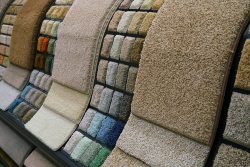From Sheep to Floor: Unpacking the Sustainable Journey of Wool Carpeting
May 15, 2023 8:09 pm Leave your thoughts From Sheep to Floor: Unpacking the Sustainable Journey of Wool Carpeting
From Sheep to Floor: Unpacking the Sustainable Journey of Wool Carpeting
The use of sustainable and eco-friendly materials in all aspects of our lives is becoming more important with each passing day. Among the many natural and renewable materials available in the market, wool is making prevalent in the carpet market. Wool carpeting has received renewed interest as an eco-friendly and natural fiber option that offers comfort and durability. Wool is a renewable and biodegradable material, and growers have practiced sustainable farming for centuries. In this blog post, we will dive deep into the journey of wool carpeting and unpack the processes that make it such a sustainable option.
From Sheep Farming to Shearing:
Sheep farming involves tending to sheep and allowing them to graze on lands that aren’t suitable for crop production. Sheep are docile animals that require minimal attention, and their manure contributes to the fertilization of the land. Shearing is a vital process in the journey of wool carpeting. Shearing removes the wool from the sheep, allowing it to grow back naturally, helping to maintain the health and comfort of the sheep. Shearing is often executed using hand-held tools, and shearers take great care to ensure that the process is painless for the sheep.
Sorting, Cleaning, and Carding:
Once separated, the wool is then cleaned to remove impurities such as dirt and sweat. The cleaning process involves washing the wool with gentle detergents, followed by thorough rinsing to get rid of any remaining residue. This washing process removes any remaining dirt or debris that could potentially harm the carpet. After cleaning, the wool is carded to smooth it out and make the carpet even and soft to the touch. Carding also ensures that the wool is consistent and helps in achieving quality carpet texture.
Spinning and Production Process:
The wool, once processed and carded, is then spun into yarn, which is subsequently used for weaving a carpet. The production of wool carpeting is a highly technical process that involves several factors that affect the quality of the carpet. Carpet density, for example, refers to the measurement of tufts per square inch and is a crucial factor in the durability and life of the carpet. In contrast, the weight of the carpet, calculated in ounces per square yard, also affects the life of a carpet.
Sustainable and Eco-Friendliness:
Wool is a natural and renewable resource that can be replenished sustainably through climate-friendly farming. This sustainable farming applies responsible sheep farming methods such as rotational grazing, which involves rotating sheep in different pastures to prevent overgrazing and damage to the land. Unlike synthetic materials like nylon and polyester that take hundreds of years to decompose, wool is biodegradable and, therefore, environmentally safer. The biodegradability of wool makes it an excellent option for reducing landfill waste.
Energy Efficiency:
Wool is an excellent natural insulator, and therefore an energy-efficient option for your home or office space. The natural insulation provided by wool carpeting helps retain heat in the winter, reduces the cost of heating, and keeps the surrounding cool in summer. This energy-saving benefit reduces costs and caters to a wider market.
Health Benefits:
Wool carpeting has several health benefits that make it an attractive option for many homeowners. Wool is hypoallergenic, which means that it does not cause allergies or irritate sensitive skin. Wool also has natural flame-retardant properties, making it a safer option than synthetic fibres that are often more flammable and less safe.
Conclusion:
Wool carpeting is an environmentally sustainable and naturally durable option for your home or office. The process that involves sheep farming, shearing, sorting, and manufacturing ensures that wool carpeting is an eco-friendly and renewable product. Compared to synthetic materials, wool’s sustainability benefits cannot be overstated: renewable resource, biodegradable, energy-efficient, and flame-retardant properties. Careful consideration of the quality of wool used and responsible manufacturing processes ensures an eco-friendly and high-quality product. Wool carpeting provides the durability, comfort, and sustainability elements that consumers look for in an eco-friendly product.
Categorised in: Wool Carpeting
This post was written by admin

 From Sheep to Floor: Unpacking the Sustainable Journey of Wool Carpeting
From Sheep to Floor: Unpacking the Sustainable Journey of Wool Carpeting